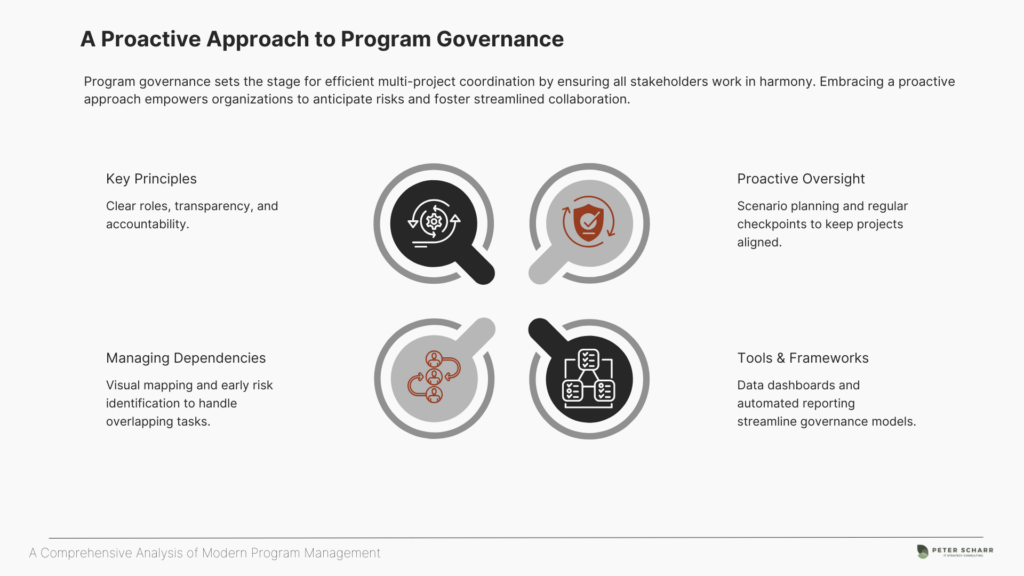Laying the Foundation: Why Proactive Governance Matters
In an era where organizations juggle multiple initiatives and cross-departmental targets, program governance becomes more than just another administrative layer. It becomes the vital conductor that ensures each project note aligns harmoniously with strategic objectives. By proactively addressing the complexities that naturally arise from ever-shifting markets, technological advances, and diverse talent pools, governance plays a key role in transforming scattered tasks into a symphony of meaningful outcomes.
Despite its importance, program governance can seem daunting if you only view it as a reactive mechanism that kicks in when things go awry. But there is a better way: embracing a proactive approach that anticipates challenges and organizes resources ahead of time. Let’s explore how this method helps decode complexity, fosters collaboration, and keeps your programs on track.
Peeling Back the Layers: How Program Governance Shapes Success
Fundamentally, program governance provides a structured framework to oversee and guide various projects under one umbrella. This oversight is not about micromanagement but about ensuring that each project aligns with broader organizational goals. A well-planned governance model outlines decision-making processes, accountability, and performance metrics. When done right, it empowers teams to function autonomously while maintaining a laser focus on strategic aims.
Complexity in Action: Navigating Multidimensional Challenges
We live in a time when organizations face overlapping priorities, rapid technological disruption, and expanding stakeholder networks. Complexity arises not only from the sheer number of projects but also from the intricate dependencies among them. Whether it’s coordinating software updates across multiple departments or balancing resource allocation among international teams, recognizing the web of interactions is essential to avoid bottlenecks. The more proactive your governance model, the faster you can identify risks and respond effectively.

Why Wait? Embracing the Early Bird in Program Governance
Delaying governance measures until problems arise can lead to budget overruns, missed milestones, and frustrated stakeholders. By contrast, a proactive stance identifies obstacles early on, integrates continuous risk assessments, and harmonizes efforts across teams. According to Gartner, organizations that instill a forward-looking governance culture are better equipped to marshal their resources efficiently, laying the groundwork for sustainable success.
Blueprint for Success: Strategies and Principles That Matter
Core Ingredients: Key Principles of Program Governance
A solid foundation begins with clarity: define roles, responsibilities, and escalation paths. Next comes transparency: communicate goals and progress updates frequently. Finally, accountability: measure milestones and outcomes, ensuring each team understands how their contributions fit the bigger picture.
Taming the Hydra: Identifying and Managing Multiple Dependencies
To manage complexity, break down projects into interconnected parts and define how they intersect. Visual mapping tools can highlight cross-functional relationships, allowing teams to see potential conflicts or overlapping objectives. As McKinsey’s research on project risk suggests, alignment becomes much simpler when communication channels are clear and established early.
Postscripting Pitfalls: Strategies for Proactive Oversight
Proactive oversight involves setting predefined checkpoints for each phase of a program, allowing for quick course corrections. It also involves scenario planning: envision possible disruptions—from supplier shortages to regulatory changes—and plan accordingly. Regular feedback loops, agile frameworks, and empowered teams help you address minor cracks before they become structural failures.
Your Governance Toolkit: Tools and Frameworks for Winning Outcomes
Modern governance often relies on dashboards, collaboration software, and automation tools to streamline reporting and oversight. Whether it’s a project management suite that integrates timelines or a risk analysis tool highlighting potential issues, having the right technologies in place can spell the difference between smooth coordination and organizational chaos. What’s critical is choosing tools that each team can adapt to, ensuring consistent data and fostering true transparency.
Stories from the Front Lines: Case Studies and Benchmarks
Turning Chaos into Cohesion: Real-Life Portfolio Management
An international manufacturing company once juggled multiple facility upgrades, new product lines, and IT implementations all in parallel. By creating a unified governance framework—complete with standardized reports and regular stakeholder briefings—they identified interdependencies early. This strategic alignment slashed resource conflicts and kept teams focused, effectively streamlining the entire portfolio.
When Good Intentions Falter: Lessons from Governance Gone Awry
Conversely, failure stories often involve weak oversight and incomplete communication plans. In one cautionary tale, a large healthcare conglomerate ran into budget overruns when separate departments each pursued digital upgrades with no central coordination. The lack of a proactive governance structure led to duplication of efforts and a spike in operational costs. The lesson? Underestimate the value of early oversight at your peril.
Scanning the Horizon: Industry-Recognized Best Practices
Industry benchmarks point toward regular steering group reviews, dedicated risk officers, and the use of agile frameworks as top ways to manage complex initiatives. Even small tweaks—such as consistent data collection and real-time dashboards—can help organizations evaluate progress and compare with external best practices, guiding continuous improvement.
Final Crescendo: Tying It All Together
Taking Stock: The Core Takeaways
Decoding program governance starts with establishing clear roles and open channels of communication. From there, recognizing and managing complex dependencies ensures no piece of the puzzle is overlooked. Proactive oversight, anchored by appropriate tools, completes the formula for forward momentum.
Keeping the Momentum: Why Consistent Engagement Matters
Ongoing stakeholder engagement and periodic reviews are the spines of a resilient governance model. The most successful programs recalibrate regularly, incorporate performance data, and pivot strategies when market conditions shift. This culture of continuous improvement is what distinguishes a reactive approach from a proactive one.
Looking Forward: Next Steps and Final Reflections
Ultimately, organizations that lean into proactive program governance are better poised to manage complexities and seize new opportunities. With the right principles, frameworks, and mindset, you transform potential pitfalls into strategic advantages—safeguarding your investments and nurturing long-term growth.
A well-orchestrated finale,



